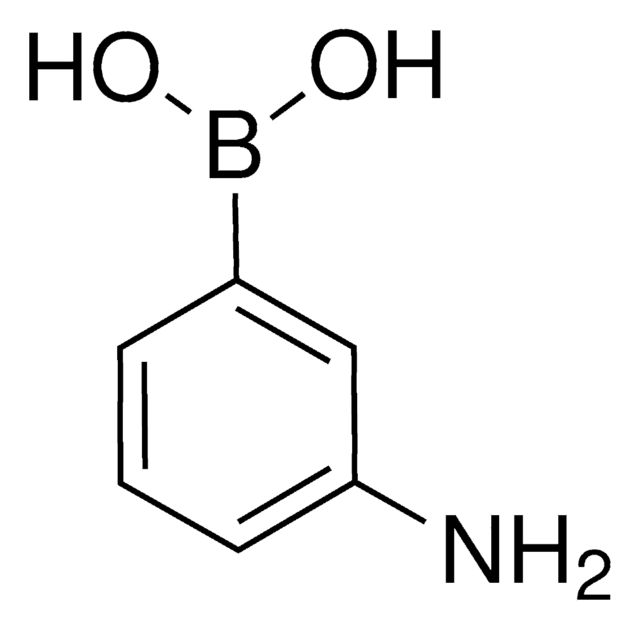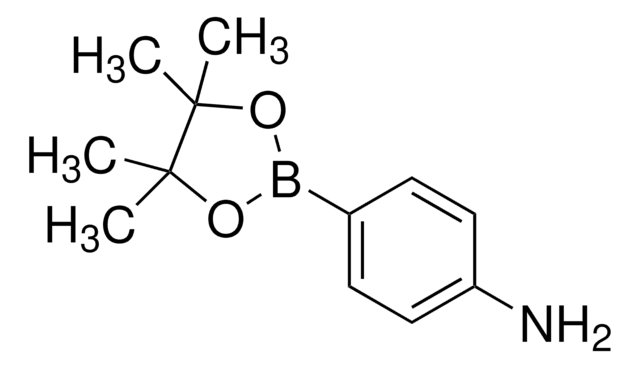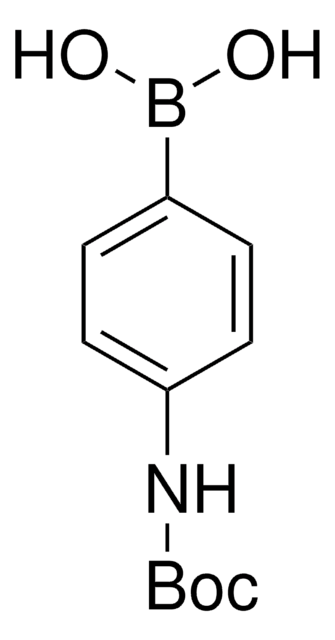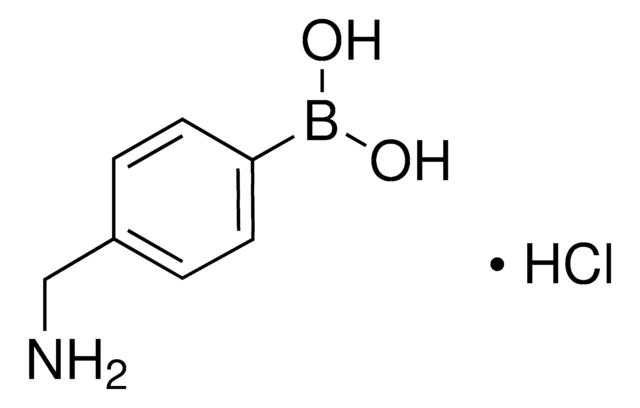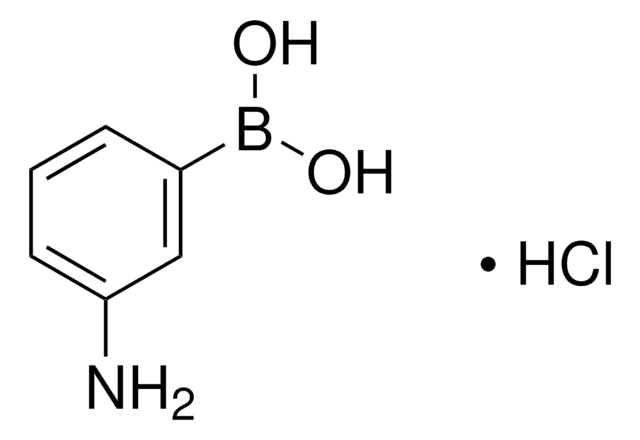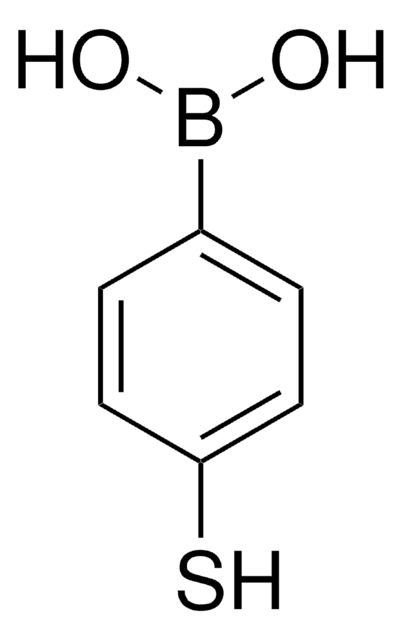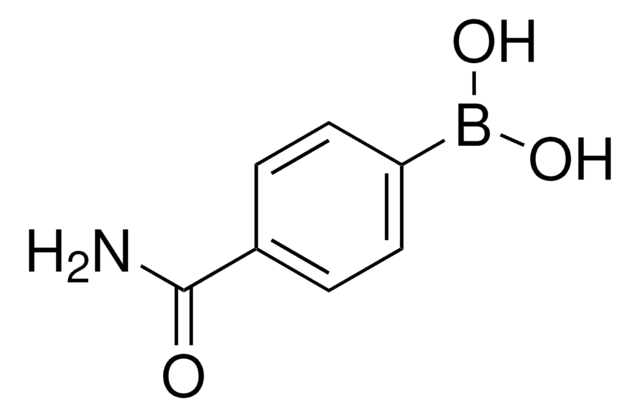708887
4-Aminophenylboronic acid hydrochloride
95%
Sinonimo/i:
4-Aminobenzeneboronic acid hydrochloride
Autenticatiper visualizzare i prezzi riservati alla tua organizzazione & contrattuali
About This Item
Formula condensata:
C6H8BNO2 · HCl
Numero CAS:
Peso molecolare:
173.41
Numero MDL:
Codice UNSPSC:
12352103
ID PubChem:
NACRES:
NA.22
Prodotti consigliati
Livello qualitativo
Saggio
95%
Forma fisica
powder
Punto di fusione
195-200 °C
Stringa SMILE
Cl.Nc1ccc(cc1)B(O)O
InChI
1S/C6H8BNO2.ClH/c8-6-3-1-5(2-4-6)7(9)10;/h1-4,9-10H,8H2;1H
QBYGJJSFMOVYOA-UHFFFAOYSA-N
Cerchi prodotti simili? Visita Guida al confronto tra prodotti
Descrizione generale
May contain varying amounts of anhydride
Applicazioni
4-Aminophenylboronic acid hydrochloride can be used to prepare:
- The modified reduced graphene composite material used as a sugar sensor to detect the analyte in fruit juice.
- The modified carbon electrode adsorbed with aminophenol, used for the detection of NADH and H2O2.
- The boron, nitrogen, and sulfur-doped carbon dot sensor, which in turn can be used for the detection of ascorbic acid.
Reactant for:
- Preparation of chromen-4-ones as DNA-dependent protein kinase inhibitors
Avvertenze
Warning
Indicazioni di pericolo
Classi di pericolo
Acute Tox. 4 Oral
Codice della classe di stoccaggio
11 - Combustible Solids
Classe di pericolosità dell'acqua (WGK)
WGK 1
Punto d’infiammabilità (°F)
Not applicable
Punto d’infiammabilità (°C)
Not applicable
Dispositivi di protezione individuale
dust mask type N95 (US), Eyeshields, Gloves
Scegli una delle versioni più recenti:
Possiedi già questo prodotto?
I documenti relativi ai prodotti acquistati recentemente sono disponibili nell’Archivio dei documenti.
I clienti hanno visto anche
Murugan Thiruppathi et al.
Talanta, 200, 450-457 (2019-05-01)
Non enzymatic detection of NADH and H2O2 is of practical significance for both environmental and biological prospective. However, there is no simple, straight forward electrochemical sensor available for sensing of them in real samples. Addressing this challenge, we report a
Qi Wang et al.
Biosensors & bioelectronics, 50, 331-337 (2013-07-25)
A sensitive electrochemical active interface for sugar sensing based on the specific boronic acid-diol binding was established. The sensing matrix was formed by stirring a suspension of graphene oxide (GO) with 4-aminophenylboronic acid (APBA). The resulting composite consists of a
Sabrina Belbekhouche et al.
Colloids and surfaces. B, Biointerfaces, 177, 416-424 (2019-02-25)
Glucose-responsive multilayer capsules have been produced through the layer-by-layer deposition of biodegradable polymers based on hydrogen bonding. The used polymers are alginate derivative and polyvinylpyrolidone (PVPON). Concentration-dependent glucose responsiveness was reached through chemical modification of alginate, selected as polyanion, with
A dual-mode sensor for colorimetric and ?turn-on? fluorescent detection of ascorbic acid
Liu Y, et al.
Dyes and Pigments, 149, 491-497 (2018)
Sun Dal Kim et al.
Science advances, 4(10), eaau1956-eaau1956 (2018-11-07)
The key component currently missing for the next generation of transparent and flexible displays is a high-performance polymer material that is flexible, while showing optical and thermal properties of glass. It must be transparent to visible light and show a
Il team dei nostri ricercatori vanta grande esperienza in tutte le aree della ricerca quali Life Science, scienza dei materiali, sintesi chimica, cromatografia, discipline analitiche, ecc..
Contatta l'Assistenza Tecnica.